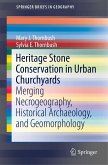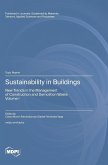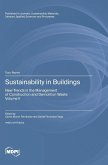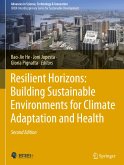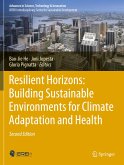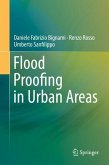The Conservation and Sustainable Development of Architectural and Urban Heritage
Acknowledgement, Protection and New Uses for Military, Modern and Industrial Landscapes
Herausgeber: Rita Fiorino, Donatella; Pilia, Elisa; Teba, Tarek
The Conservation and Sustainable Development of Architectural and Urban Heritage
Acknowledgement, Protection and New Uses for Military, Modern and Industrial Landscapes
Herausgeber: Rita Fiorino, Donatella; Pilia, Elisa; Teba, Tarek
- Gebundenes Buch
- Merkliste
- Auf die Merkliste
- Bewerten Bewerten
- Teilen
- Produkt teilen
- Produkterinnerung
- Produkterinnerung
This book offers a rich, cross-disciplinary examination of military, modern, and industrial heritage through fresh perspectives on interpretation, reuse, and technological integration. Structured into five focused sections, it explores strategies for reimagining defensive structures, institutional architecture, and post-industrial landscapes throughout Europe. Case studies range from fortified complexes and decommissioned prisons to socialist-era sports halls and heritage rail stations, revealing the cultural layers and design challenges inherent in their protection and renewal. This book…mehr
Andere Kunden interessierten sich auch für
![Heritage Stone Conservation in Urban Churchyards Heritage Stone Conservation in Urban Churchyards]() Mary J. ThornbushHeritage Stone Conservation in Urban Churchyards38,99 €
Mary J. ThornbushHeritage Stone Conservation in Urban Churchyards38,99 €![Technological Choices for Sustainability Technological Choices for Sustainability]() Technological Choices for Sustainability113,99 €
Technological Choices for Sustainability113,99 €![Sustainability in Buildings Sustainability in Buildings]() Sustainability in Buildings138,99 €
Sustainability in Buildings138,99 €![Sustainability in Buildings Sustainability in Buildings]() Sustainability in Buildings135,99 €
Sustainability in Buildings135,99 €![Resilient Horizons: Building Sustainable Environments for Climate Adaptation and Health Resilient Horizons: Building Sustainable Environments for Climate Adaptation and Health]() Resilient Horizons: Building Sustainable Environments for Climate Adaptation and Health166,99 €
Resilient Horizons: Building Sustainable Environments for Climate Adaptation and Health166,99 €![Resilient Horizons: Building Sustainable Environments for Climate Adaptation and Health Resilient Horizons: Building Sustainable Environments for Climate Adaptation and Health]() Resilient Horizons: Building Sustainable Environments for Climate Adaptation and Health151,99 €
Resilient Horizons: Building Sustainable Environments for Climate Adaptation and Health151,99 €![Flood Proofing in Urban Areas Flood Proofing in Urban Areas]() Daniele Fabrizio BignamiFlood Proofing in Urban Areas98,99 €
Daniele Fabrizio BignamiFlood Proofing in Urban Areas98,99 €-
-
-
This book offers a rich, cross-disciplinary examination of military, modern, and industrial heritage through fresh perspectives on interpretation, reuse, and technological integration. Structured into five focused sections, it explores strategies for reimagining defensive structures, institutional architecture, and post-industrial landscapes throughout Europe. Case studies range from fortified complexes and decommissioned prisons to socialist-era sports halls and heritage rail stations, revealing the cultural layers and design challenges inherent in their protection and renewal. This book highlights the application of advanced digital methodologies—such as GeoAI mapping, HBIM systems, and cost-effective 3D modelling—to enhance understanding, planning, and stewardship. It also investigates material conservation and the intersection of modern heritage with contemporary energy and sustainability goals. Emphasizing inclusive narratives, socio-cultural relevance, and innovation in practice, this book serves as a vital reference for designers, conservationists, policy-makers, and academics committed to preserving the character and meaning of built environments while adapting them for future needs.
Produktdetails
- Produktdetails
- Advances in Science, Technology & Innovation
- Verlag: Springer International Publishing AG / Springer-Verlag GmbH
- Artikelnr. des Verlages: 89583456
- Erscheinungstermin: 24. März 2026
- Englisch
- Abmessung: 279mm x 210mm
- ISBN-13: 9783032120410
- ISBN-10: 3032120411
- Artikelnr.: 75697690
- Herstellerkennzeichnung
- Springer-Verlag GmbH
- Tiergartenstr. 17
- 69121 Heidelberg
- ProductSafety@springernature.com
- Advances in Science, Technology & Innovation
- Verlag: Springer International Publishing AG / Springer-Verlag GmbH
- Artikelnr. des Verlages: 89583456
- Erscheinungstermin: 24. März 2026
- Englisch
- Abmessung: 279mm x 210mm
- ISBN-13: 9783032120410
- ISBN-10: 3032120411
- Artikelnr.: 75697690
- Herstellerkennzeichnung
- Springer-Verlag GmbH
- Tiergartenstr. 17
- 69121 Heidelberg
- ProductSafety@springernature.com
Dr. Donatella Rita Fiorino is an associate professor of Restoration at the Department of Civil-Environmental and Architectural Engineering, University of Cagliari. She is an engineer, Ph.D. in Conservation of Architectural Heritage, and a specialist in the Restoration of Monuments at the Milan Polytechnic, ICOMOS and ICOFORT expert member, a member of the Italian Society for Architectural Conservation/ Restoration (SIRA), a member of the Organizing Committee of the School of Specialization in Architectural Heritage and Landscape, and involved in national PhD boards. Her research focuses on the recognition and analysis of cultural heritage with special attention to vast urban complexes, fortified systems, city walls, industrial areas, and military sites. She is responsible of a collaboration agreement with the Italian Ministry of Defence and is the founder of the “Military Landscapes” international scientific networks. She collaborates with several universities and national and international research Institutions. Dr. Tarek Teba is an associate professor in Architectural Heritage in School of Architecture, University of Portsmouth and the Chair for ICOMOS UK Digital Technology National Committee. Tarek is the course leader of MA Architecture: Building and Heritage Conservation and the co-chair of the University of Portsmouth Heritage Research Hub. Tarek’s research concerns the conservation of tangible and intangible heritage through creating the balance between contemporary values via community engagement and historic, aesthetic and cultural values. Tarek explores methodological approaches to preserve the cultural and contemporary social values embedded in heritage assets and cities. He uses community engagement and cultural mapping as an informing tool and a virtual modelling and digital heritage approaches as a vehicle to deliver adaptation and development strategies. Dr. Elisa Pilia is an assistant professor in the field of Restauration at the Department of Civil-Environmental and Architectural Engineering, University of Cagliari. She is a conservator of Architectural and Environmental Heritage, Ph.D. in Civil Engineering and Architecture (in collaboration with the University of Edinburgh—Scottish Centre for Conservation Studies) and a specialist in Architectural and Landscape Heritage (University of Naples Federico II). Also, she is the author of publications on the protection, conservation and enhancement of the historical-architectural heritage, with particular attention to heritage in the state of ruination, the restoration of archaeological monuments and the reuse of military complexes, both nationally and internationally.
Interpretation of the military cultural landscapes of the ICOMOS guidelines
on Fortifications and Military Heritage (2021).- The architectural
promenade of the walls of Pisa.- Heritage is plural. Recovery and adaptive
reuse of the Polveriera Castelfidardo in Ancona.- The SOSLabs Project. An
Integrated Approach for the reuse of Historical State-Owned Heritage.-
Knowledge and Conservation of Historic Prisons built in fragile
territories: the case of the Avalos Complex in Procida.- Military Heritage
Conservation and Regeneration: A Categorisation Approach to Identify the
Most Challenging Military Heritage Typologies in the UK.- Military Digital
Landscapes. An overview of GeoAI methodologies for Built and Landscape
Heritage documentation.- Multisource approach in the 3D documentation of an
alpine defensive system: the Vallo Alpino in the Gardetta Plateau area
(CN).- Use of Low-Cost Spherical Camera for the Cultural Heritage 3D
model.- Raumbuch and HBIM: an integrated approach for the redevelopment of
the “Palazzo de La Vallée” in Cagliari.- Conservation and restoration in
the 21st century. Reflections on the cultural significance, identity, and
authenticity of cultural heritage.- The preservation of typological
features of asylum architecture: from decommissioning to reuse.- Can
Romanian socialist sports halls be historical monuments?.- To bring you the
monument itself”. Bogdan Bogdanovi¿’s memorials in Serbia caught between
cultural value and denial.- Valorisation of ex-Yugoslav dissonant heritage
from transnational perspectives.- Towards the adaptive reuse of town
centres buildings at scale in Ireland: Introducing the Trebuchet project.-
Modern materials; A legacy from 20th Century Italy.- Preventive
Conservation of Concrete University Buildings: A Study of the Conservation
Plan for the Vilanova Artigas Building.- An Archaeology of Architecture for
the Contemporary Architecture.- Modern Heritage Preservation in the context
of Energy Transition. 20th Century School Architecture: a Living Heritage.-
THE INDUSTRIAL HERITAGE UNDER THE THREAT OF “REUSE”.- Contextually
Sensitive Analysis of the Social Sustainability in the Industrial Heritage
Quarter Regeneration.- Knowledge for the restoration of
industrial-archaeological heritage: the case of the former Garofalo pasta
factory in Gragnano (NA).- New Design in Heritage Rail Stations: Balancing
Conservation and Modernization.
on Fortifications and Military Heritage (2021).- The architectural
promenade of the walls of Pisa.- Heritage is plural. Recovery and adaptive
reuse of the Polveriera Castelfidardo in Ancona.- The SOSLabs Project. An
Integrated Approach for the reuse of Historical State-Owned Heritage.-
Knowledge and Conservation of Historic Prisons built in fragile
territories: the case of the Avalos Complex in Procida.- Military Heritage
Conservation and Regeneration: A Categorisation Approach to Identify the
Most Challenging Military Heritage Typologies in the UK.- Military Digital
Landscapes. An overview of GeoAI methodologies for Built and Landscape
Heritage documentation.- Multisource approach in the 3D documentation of an
alpine defensive system: the Vallo Alpino in the Gardetta Plateau area
(CN).- Use of Low-Cost Spherical Camera for the Cultural Heritage 3D
model.- Raumbuch and HBIM: an integrated approach for the redevelopment of
the “Palazzo de La Vallée” in Cagliari.- Conservation and restoration in
the 21st century. Reflections on the cultural significance, identity, and
authenticity of cultural heritage.- The preservation of typological
features of asylum architecture: from decommissioning to reuse.- Can
Romanian socialist sports halls be historical monuments?.- To bring you the
monument itself”. Bogdan Bogdanovi¿’s memorials in Serbia caught between
cultural value and denial.- Valorisation of ex-Yugoslav dissonant heritage
from transnational perspectives.- Towards the adaptive reuse of town
centres buildings at scale in Ireland: Introducing the Trebuchet project.-
Modern materials; A legacy from 20th Century Italy.- Preventive
Conservation of Concrete University Buildings: A Study of the Conservation
Plan for the Vilanova Artigas Building.- An Archaeology of Architecture for
the Contemporary Architecture.- Modern Heritage Preservation in the context
of Energy Transition. 20th Century School Architecture: a Living Heritage.-
THE INDUSTRIAL HERITAGE UNDER THE THREAT OF “REUSE”.- Contextually
Sensitive Analysis of the Social Sustainability in the Industrial Heritage
Quarter Regeneration.- Knowledge for the restoration of
industrial-archaeological heritage: the case of the former Garofalo pasta
factory in Gragnano (NA).- New Design in Heritage Rail Stations: Balancing
Conservation and Modernization.
Interpretation of the military cultural landscapes of the ICOMOS guidelines
on Fortifications and Military Heritage (2021).- The architectural
promenade of the walls of Pisa.- Heritage is plural. Recovery and adaptive
reuse of the Polveriera Castelfidardo in Ancona.- The SOSLabs Project. An
Integrated Approach for the reuse of Historical State-Owned Heritage.-
Knowledge and Conservation of Historic Prisons built in fragile
territories: the case of the Avalos Complex in Procida.- Military Heritage
Conservation and Regeneration: A Categorisation Approach to Identify the
Most Challenging Military Heritage Typologies in the UK.- Military Digital
Landscapes. An overview of GeoAI methodologies for Built and Landscape
Heritage documentation.- Multisource approach in the 3D documentation of an
alpine defensive system: the Vallo Alpino in the Gardetta Plateau area
(CN).- Use of Low-Cost Spherical Camera for the Cultural Heritage 3D
model.- Raumbuch and HBIM: an integrated approach for the redevelopment of
the “Palazzo de La Vallée” in Cagliari.- Conservation and restoration in
the 21st century. Reflections on the cultural significance, identity, and
authenticity of cultural heritage.- The preservation of typological
features of asylum architecture: from decommissioning to reuse.- Can
Romanian socialist sports halls be historical monuments?.- To bring you the
monument itself”. Bogdan Bogdanovi¿’s memorials in Serbia caught between
cultural value and denial.- Valorisation of ex-Yugoslav dissonant heritage
from transnational perspectives.- Towards the adaptive reuse of town
centres buildings at scale in Ireland: Introducing the Trebuchet project.-
Modern materials; A legacy from 20th Century Italy.- Preventive
Conservation of Concrete University Buildings: A Study of the Conservation
Plan for the Vilanova Artigas Building.- An Archaeology of Architecture for
the Contemporary Architecture.- Modern Heritage Preservation in the context
of Energy Transition. 20th Century School Architecture: a Living Heritage.-
THE INDUSTRIAL HERITAGE UNDER THE THREAT OF “REUSE”.- Contextually
Sensitive Analysis of the Social Sustainability in the Industrial Heritage
Quarter Regeneration.- Knowledge for the restoration of
industrial-archaeological heritage: the case of the former Garofalo pasta
factory in Gragnano (NA).- New Design in Heritage Rail Stations: Balancing
Conservation and Modernization.
on Fortifications and Military Heritage (2021).- The architectural
promenade of the walls of Pisa.- Heritage is plural. Recovery and adaptive
reuse of the Polveriera Castelfidardo in Ancona.- The SOSLabs Project. An
Integrated Approach for the reuse of Historical State-Owned Heritage.-
Knowledge and Conservation of Historic Prisons built in fragile
territories: the case of the Avalos Complex in Procida.- Military Heritage
Conservation and Regeneration: A Categorisation Approach to Identify the
Most Challenging Military Heritage Typologies in the UK.- Military Digital
Landscapes. An overview of GeoAI methodologies for Built and Landscape
Heritage documentation.- Multisource approach in the 3D documentation of an
alpine defensive system: the Vallo Alpino in the Gardetta Plateau area
(CN).- Use of Low-Cost Spherical Camera for the Cultural Heritage 3D
model.- Raumbuch and HBIM: an integrated approach for the redevelopment of
the “Palazzo de La Vallée” in Cagliari.- Conservation and restoration in
the 21st century. Reflections on the cultural significance, identity, and
authenticity of cultural heritage.- The preservation of typological
features of asylum architecture: from decommissioning to reuse.- Can
Romanian socialist sports halls be historical monuments?.- To bring you the
monument itself”. Bogdan Bogdanovi¿’s memorials in Serbia caught between
cultural value and denial.- Valorisation of ex-Yugoslav dissonant heritage
from transnational perspectives.- Towards the adaptive reuse of town
centres buildings at scale in Ireland: Introducing the Trebuchet project.-
Modern materials; A legacy from 20th Century Italy.- Preventive
Conservation of Concrete University Buildings: A Study of the Conservation
Plan for the Vilanova Artigas Building.- An Archaeology of Architecture for
the Contemporary Architecture.- Modern Heritage Preservation in the context
of Energy Transition. 20th Century School Architecture: a Living Heritage.-
THE INDUSTRIAL HERITAGE UNDER THE THREAT OF “REUSE”.- Contextually
Sensitive Analysis of the Social Sustainability in the Industrial Heritage
Quarter Regeneration.- Knowledge for the restoration of
industrial-archaeological heritage: the case of the former Garofalo pasta
factory in Gragnano (NA).- New Design in Heritage Rail Stations: Balancing
Conservation and Modernization.


